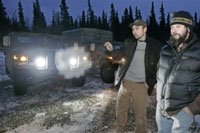 Army tests soldiers in Alaskan extremes
Army tests soldiers in Alaskan extremes
by Rachel D’Oro
DELTA JUNCTION, Alaska – The Humvee’s headlights shone incredibly bright, casting daylight clarity on a line of spruce trees, every needle standing out in stark contrast to the dark night of Alaska’s interior. Next to the vehicle, the incandescent lights on another Humvee glowed like mere candles. It was time to study an emerging technology in one of the harshest places on earth, the Army’s sprawling Cold Regions Test Center near Fort Greely.
The center includes man-made ice fields, snow rinks and sharp slopes for rating equipment, weapons and clothing in temperatures that can pitch past 60 degrees below zero and winds so fierce they can whip snow into a blinding fog.
“We get to play with all the cool toys before the Army does. Watch this,” said Jeff Lipscomb, the center’s technical director, as he sent his SUV sliding across a skid pad on the center’s 2,500-acre Mobility Test Complex.
Strange things happen when thermometers nose-dive to Alaska extremes. Metal can break, rubber can crack, motor oil can turn hard as a rock, human beings can freeze to death…
That’s why the Army established the test center in 1949, to develop gear that can hold up in the coldest regions of the world. It was a response to World War II, when thousands of U.S. troops sustained cold-weather injuries, such as frostbite, in Europe.
It’s the frigid version of several testing sites operating under the Army Test and Evaluation Command in extreme natural settings, including desert and tropic environments, that can significantly affect the performance of soldiers and equipment. Winters here are consistently brutal because mountains to the north and south allow dense arctic air to settle over the landlocked region.
The center, about 100 miles southeast of Fairbanks, is the military’s only test site on U.S. soil that can replicate conditions of a battlefield in subzero conditions. Test crews also have access to another 670,000 acres of surrounding ranges, off-road courses and controlled airspace.
Among the current projects here are those luminous headlights, which are being developed for the Army by Falconer, N.Y.-based Truck-Lite Co.
Equipping vehicles with light-emitting diode or LED headlamps bright enough for nighttime use was no more than a concept three years ago. Generally known as the tiny lights that illuminate watches, dashboards and electronics, energy saving LED headlights are now a promising technology being tried out in severe environments.
LED lights are much easier on the eyes, despite their brightness, and they should last through the 20- to 30-year life of military vehicles, predicted Marty Snyder, a project engineer with the Army’s Tank-automotive and Armaments Command based in Warren, Mich. Ultimately such headlights will wind up on commercial vehicles as well good news for motorists annoyed by the bluish high-intensity discharge lights, Snyder said.
In their third phase of development, the prototype lights are performing favorably despite a few drawbacks, according to Snyder. For example, their high beams failed in hot weather at test sites in Panama and near Carson City, Nev.
“It’s a thermal-related component and a very easily corrected problem,” Snyder said. “Their performance in Alaska has been positive. I’m very, very pleased with the progress of the development of this lamp.”
So are David Hoffman and John Viggato, civilian testers at the center. LED lights use less juice in the cold than conventional headlights, the men said. Plus, they’re whiter and reach farther.
“They tend to penetrate blowing snow, so you can see better instead of looking at a huge fog,” Viggato said. “It just takes a little getting used to. There’s no soft glow. It’s crisp.”
Commercial clients, including automakers and suppliers, also put their products through punishing exercises here.
Among them are TRW Automotive. In October, the company tested brakes it is developing for automaker DaimlerChrysler for a 2007 line. The goal was to gauge the product’s performance on the slickest roads and most challenging backcountry trails, said Tom Oginsky, chief development engineer for electronic braking systems with TRW, based in Livonia, Mich., just outside Detroit.
Car companies are shortening their development cycles, so it’s crucial to work faster, Oginsky said. Alaska, and similar places such as Sweden, allows them to get the most out of winter conditions.
“The thing that struck me the most about the Alaska setting is the potential,” Oginsky said. “There are new facilities, everything is very well maintained, there’s a very capable crew. I saw an investment already made. The infrastructure is there and we’re taking advantage of it.”
But the military, including other services, remains the main focus at the center. Over the years, it’s seen the whole gamut of soldier wares.
“We’ve done everything from hats to helicopters, boots to tanks, gloves to missiles,” Lipscomb said. “If someone has a need to test something, we can get it done here.”
ATTENTION READERS
We See The World From All Sides and Want YOU To Be Fully InformedIn fact, intentional disinformation is a disgraceful scourge in media today. So to assuage any possible errant incorrect information posted herein, we strongly encourage you to seek corroboration from other non-VT sources before forming an educated opinion.
About VT - Policies & Disclosures - Comment Policy



